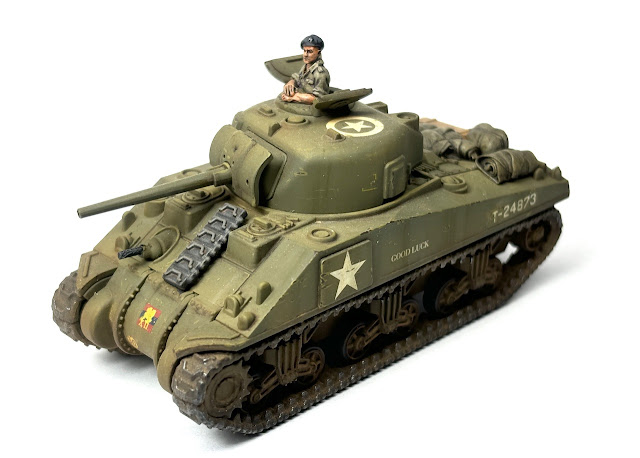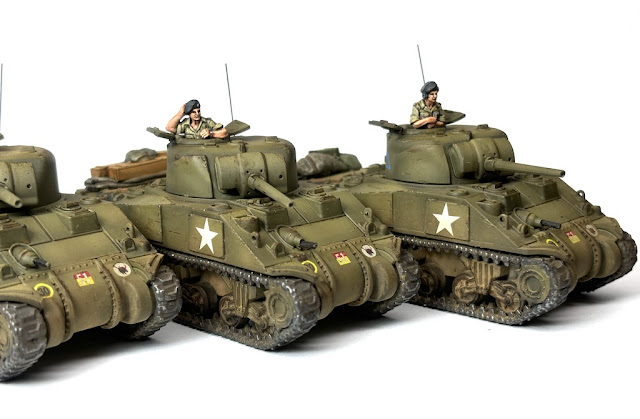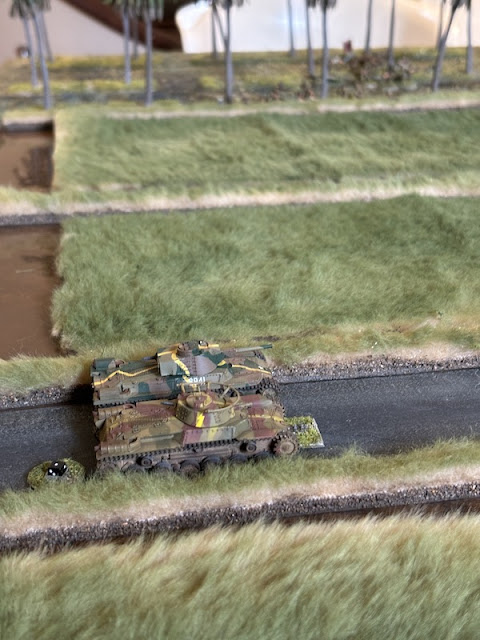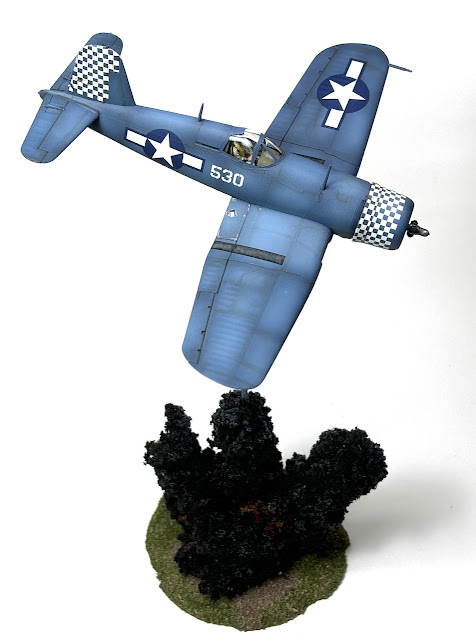Chain of Command is at heart a platoon level game and I often tell people who are just starting that they really don't need too much in the way of armour and other supports. Why is it then, I ask myself, that I always seem to be adding more and more to the collection?
Sometimes the additions are planned and sometimes they are serendipitous. When I was visiting the Tank Museum at Bovington last year I came across a boxed set of PSC 1/72 M4A4 Shermans in the gift shop. These have been hard to track down of late and I've been eager to add more to my collection for the late war in Burma. The PSC models are sturdy gaming pieces, but that comes at a cost of chunky detail. I addressed some of that by drilling out the lifting hooks; replacing the bow MGs; drilling out the 75mm gun barrel and adding aerials.
I find I can be very productive with the airbrush when painting in batches. I've had a couple of PSC StuG III primed and waiting to be painted. As I'm playing the Old Hickory campaign at the moment I thought it wouldn't do any harm to have a few more StuGs to hand. I tried to give these quite a worn look and paid particular attention to making the side schurzen look chipped and worn.
The addition of foliage made from rubberised coconut fibre and model railway leaves gave it a particularly suitable appearance for German armour in Normandy.
When 172 Scale Miniatures had a 50% off sale I found it hard to resist the urge to fill a few gaps. It didn't help that I was playing a game in the Driving Charge campaign for Chain of Command and my opponent surprised me by taking three Type 97 Chi Ha as a support choice. I didn't have three of the early variant, I had only two of the old Airfix Chi Ha and one of the 172 Scale later model Shinhoto Chi Ha, which proxied for the missing earlier model.
The sale at 172 Scale Miniatures was the perfect opportunity to make good this deficit. I knew the Airfix Chi Ha at 1/76 scale was unlikely to match those from 172 Scale Miniatures so I ordered three early model Chi Ha and then added another two of the Shinhoto versions to give me three of each type. Excessive? Probably, but I think it guarantees I'm covered should a similar situation arise.
Anyhow, did I mention I can be particularly productive with the airbrush when painting in batches?
The distinctive yellow lines over the Japanese camouflage was a feature of the early war and was no longer in use after 1942, so the Shinhoto versions I have painted in a late war three colour scheme.
While I was researching the Saipan scenario for CanCon that I ran earlier this year, I discovered that quite a few Shinhoto tanks were used during the Japanese counterattack against the beachhead, so I didn't really need any convincing that this should be the subject of my scenario. Everything happens for a reason (at least that's how I convince myself all this makes any sense).
The colour scheme for the early model Chi Ha retained the yellow lines. From what I understand Japanese tanks were not repainted in the field and any tank still in service after 1942 was quite likely to retain those earlier markings, so that even if these were to appear in games set in the late war they wouldn't look out of place.
While painting those, I also completed a couple of diminutive Type 97 tankettes. These are from S-Model, plastic kits from China and a manufacturer who's products I like a lot. With two kits in a box they offer value, as well as a high degree of detail for a quick build model.
This particular set comes with decals for the Chinese PLA which used captured versions, but I've painted them as Japanese with decals from Skytrex.
While air support does exist in Chain of Command, it is abstracted in the rules. There is no need to actually represent it on the table with models. However, that's never stopped me. Even since I built the Airfix Stuka to use in the AARs for our Many Rivers to Cross campaign I've wanted to find a way to incorporate models on the table to remind us that the effects of air support are in play.
In the Far East I did something similar for the Zero Attack! for the Japanese.
And the Hurribomber for the British.
It goes without saying I was keen to do it for other forces. If nothing else, I find making aircraft an enjoyable diversion. While the Pacific Handbook for Chain of Command has yet to be released I find it hard to imagine the US Marines won't have access to some form of air support. I've always found the Corsair F4 an attractive looking plane, there is something quite elegant about the gull wings. With little encouragement needed I picked up an inexpensive 1/72 kit from Hasegawa.
As I've done with the Zero I've modelled this without the propellor blades so that it doesn't look too static. I did experiment with discs of clear plastic to represent the spinning blades but they ended up looking like, well, discs of clear plastic. I think the impression of movement is just as obvious with nothing there.
While I was in the model shop I spotted a Mustang P51A, the earlier version before the bubble canopy was introduced. This kit from Italeri came with decals for the 1st Air Commando of the 10th Air Force, a unit that flew close support missions for the Chindits in Burma. That was just too tempting. I have written a campaign for the Chindits that exists in draft form, it may be that I need to revise that to introduce an element of air support now that I have a suitable aircraft.
































Excellent
ReplyDeleteThanks!
DeleteExcellent work all round Mark, love the subtle shading and weathering effects you have achieved.
ReplyDeleteThanks Phil, the airbrush can do wonders sometimes!
DeleteYour airbrush work is very effective - the picture of a sherman on the front cover of the book looks like a photo of one of your models! The planes also always look better with an airbrush, but I'm too tight, and stuck in my ways, to get one. It would be great to see a Vultee Vengeance for your Burma games - such an unloved, and overlooked, beast of a warbird.
ReplyDeleteI’ve had an airbrush (two actually) for 20+ years and started using them when I was modelling, not gaming. Both compressor and airbrushes have delivered faithful service and are still ticking along, in that sense they have proven a good investment. I’d love to add a Vultee Vengeance but, you’re right, it’s very unloved. The only one available in 1/72 is by a boutique manufacturer and comes with a hefty price tag when compared to Hasegawa or Italeri. As compensation I’ve treated myself to a P47 Thunderbolt which I’ll paint up for Burma.
DeleteA quick look at eBay showed several (SMER & Revell) for £12-15 and even one for £7.99 by Plastyk(?) albeit here in the UK. Never mind though, I’m also a fan of the ‘Jug’.
DeleteOustanding work and great photos. This inspires me to be more productive on my 1/72 collection. I enjoyed the photos from the game boards over the years. Great terrain and very inspiring. Keep up the good work.
ReplyDeleteThanks very much, as the Australian summer starts to wind down and my personal commitments are less hectic (new grandson born in mid January) gaming life should return to normal and game report posts should be more frequent.
DeleteWhat happened? Hope all is OK! why republish older articles that are stored on your site anyway? A Worried Dick Bryant
ReplyDeleteNot quite sure what you mean Dick. The Shermans, StuGs, Corsair and Mustang are new and haven’t been posted on the blog before, only the Japanese tanks made a brief appearance in an earlier post. I’ve included a few older pictures in this post just to put some of these new additions in context. All is okay in my world, rest assured! That said I’ve had a hectic January/February - summer holidays, a new grandchild and a three day gaming event at CanCon.
DeleteBeautiful work!
ReplyDeleteThank you!
DeletePhenomenal work!
ReplyDeleteVery kind, thanks!
Delete